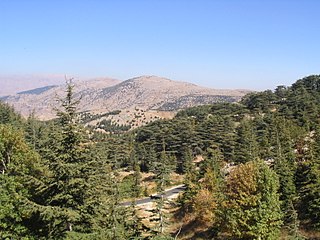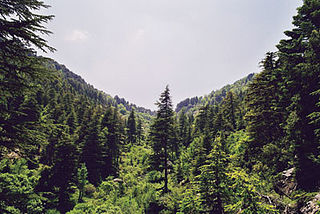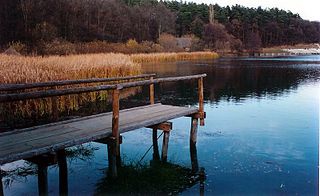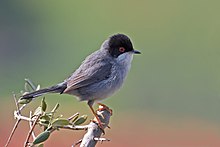
Ladakh is the home to endemic Himalayan wildlife, such as the bharal, yak, Himalayan brown bear, Himalayan wolf and the iconic snow leopard. Hemis National Park, Changthang Cold Desert Wildlife Sanctuary, and Karakorum Wildlife Sanctuary are protected wildlife areas of Ladakh. The Mountain Institute, the Ladakh Ecological Development Group and the Snow Leopard Conservancy work on ecotourism in rural Ladakh. For such an elevated, arid area, Ladakh has great diversity of birds — 318 species have been recorded. Many of these birds reside at or seasonally breed in high-altitude wetlands, such as Tso Moriri, or near rivers and water sources.

Viticuso is a comune (municipality) in the Province of Frosinone in the Italian region Lazio, located about 130 kilometres (81 mi) southeast of Rome and about 50 kilometres (31 mi) east of Frosinone.

The wildlife of Azerbaijan consists of its flora and fauna and their natural habitats.

Al Shouf Cedar Nature Reserve is a nature reserve in the Chouf and Aley districts of Lebanon. It is located on the slopes of Jebel Baruk mountain and has an area of 550 km2 (210 sq mi), nearly 5.3% of the Lebanese territory, making it the largest natural reserve in Lebanon.

Golden Sands Nature Park is a nature park on the Bulgarian Black Sea Coast in Varna Province.

Horsh Ehden is a nature reserve located in Northern Lebanon. It contains a forest of the cedar of Lebanon, making it a part of the country's cultural and natural heritage. Located on the northwestern slopes of Mount Lebanon, the nature reserve experiences high precipitation and is home to numerous rare and endemic plants. Stands of cedars also include a mixed forest of juniper, fir, and the country's last protected community of wild apple trees. In the forest are endangered eastern imperial eagles or Bonelli's eagles, gray wolves, wildcats, golden jackals, and red foxes. Valleys and gorges also have wild orchids, salamanders, mushrooms, and other flora and fauna.
This is a list of the fauna of Finland. Finland borders Sweden to the west, Russia to the east, and Norway to the north, while Estonia lies to its south across the Gulf of Finland, allowing an ecological mix. Finland contains many species of mammals, birds, and fish, but only a few reptiles and amphibians. This article discusses all the vertebrate animals which can be found on Finland itself, not the oceans.

The Elburz Range forest steppe ecoregion is an arid, mountainous 1,000-kilometer arc south of the Caspian Sea, stretching across northern Iran from the Azerbaijan border to near the Turkmenistan border. It covers 63,300 square kilometres (24,400 sq mi) and encompasses the southern and eastern slopes of the Alborz Mountains as well as their summits. The Caspian Hyrcanian mixed forests ecoregion's lush green mountainsides and plains receive moisture from the Caspian Sea from this ecoregion's northern border. The vast Central Persian desert basins ecoregion forms its southern border.

The Mureș Floodplain Natural Park, set aside by the Romanian government in 2005, is located in western Romania outside the city of Arad. The park covers 17,455 ha and follows the river Mureș westward from the city of Arad to the Hungarian border. The park is a typical ecosystem for wetlands, with running waters, lakes, swamps and floodplains, with forests, an important place for the passage and nesting of bird species and is subjected to periodical floods. The forests in the park are made up primarily of common oak, narrow-leafed ash, black and white poplar, white willow, and American black walnut. This area is an important place for nesting and passage for nearly 200 species of birds, most of which are strictly protected internationally.
Romania has a long history of hunting and remains a remarkable hunting destination, drawing many hunters because of its large numbers of brown bears, wolves, wild boars, red deer, and chamois. The concentration of brown bears in the Carpathian Mountains of central Romania is largest in the world and contains half of all Europe's population, except Russia.

The Ajloun Forest Reserve is a nature reserve located in the Ajloun Governorate in north-west Jordan. Established by the Royal Society for the Conservation of Nature in 1988 in the area around the village of Umm Al-Yanabi, it comprises an area of 13 square kilometres (5 sq mi). The reserve is houses a captive breeding programme for the locally extinct roe deer and has been declared an Important Bird Area by BirdLife International. There are also a number of hiking trails for tourists.
Lapiș Forest nature reserve IUCN category IV, is located in northwestern Romania, in the west of Sălaj County, near the village of Nușfalău, which is about 9 km from Șimleu Silvaniei.

Mount Stogu is a protected area situated in the administrative territory of Băile Olăneşti, in Vâlcea County within east Romania.

The Dumbrava Sibiului Natural Park is a protected area situated in central Romania, in Sibiu County, in administrative territory of Sibiu city.

Shatsk National Natural Park is a national park of Ukraine which was established in 1983 and aimed to preserve, reconstitute and to use effectively Volyn Polissia natural complexes and objects of special environmental, recreational, educational and aesthetic value. The park is located on the territory of Kovel Raion in northwest part of Volyn Oblast. The general area of the park is 490 square kilometres (190 sq mi), 188 km2 (73 sq mi) of which are handed over for its permanent use. Lesia Ukrainka Volyn State University is a scientific curator. Two ecological paths, Svitiazianka and Lisova Pisnia, are working in the Shatsk NNP.

The Natural Regional Park of Serre is a protected natural area of Calabria, Italy created in 2004.

The Aegean and Western Turkey sclerophyllous and mixed forests is an ecoregion in the lands around the Aegean Sea. The ecoregion covers most of mainland Greece, the Greek Aegean Islands, the western coast of Turkey, the southern Vardar river valley in North Macedonia, the southern Struma river valley at the extreme south-western corner of Bulgaria.
The bay of Porto Conte is a natural inlet on the Riviera del Corallo, a locality on the northwest coast of Sardinia, in the sea of the same name, protected following the establishment of the Porto Conte Regional Nature Park. It is enclosed between the karst promontories of Capo Caccia and Punta Giglio and faces the Alghero roadstead; it is about 20 km from Alghero itself. It measures from the mouth to the bottom 6 km, with a width of about 2.5 km. The coastal part consists of small inlets, cliffs, and the long sandy beach of Mugoni pine forest.
















